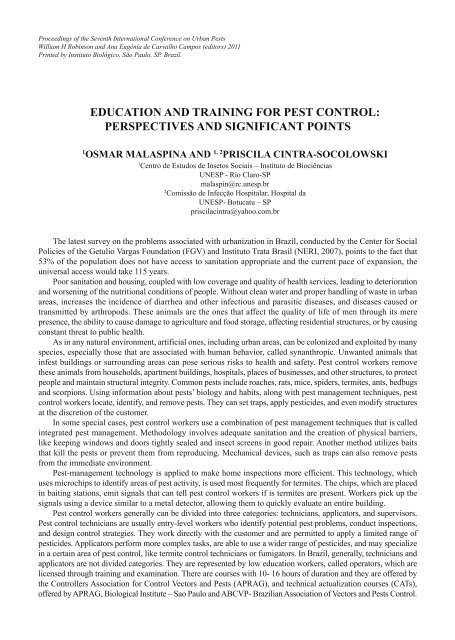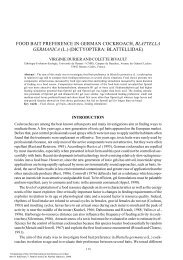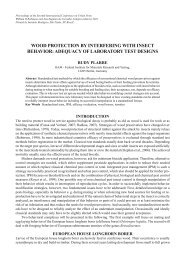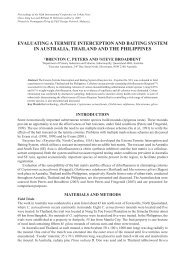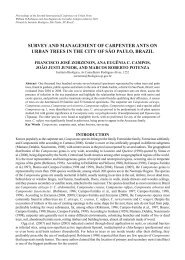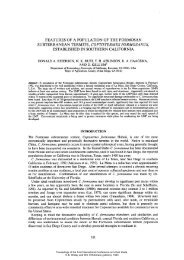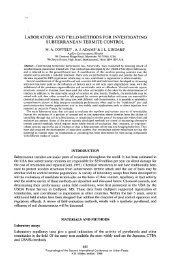Full paper - International Conference on Urban Pests
Full paper - International Conference on Urban Pests
Full paper - International Conference on Urban Pests
Create successful ePaper yourself
Turn your PDF publications into a flip-book with our unique Google optimized e-Paper software.
Proceedings of the Seventh <str<strong>on</strong>g>Internati<strong>on</strong>al</str<strong>on</strong>g> <str<strong>on</strong>g>C<strong>on</strong>ference</str<strong>on</strong>g> <strong>on</strong> <strong>Urban</strong> <strong>Pests</strong><br />
William H Robins<strong>on</strong> and Ana Eugênia de Carvalho Campos (editors) 2011<br />
Printed by Instituto Biológico, São Paulo, SP. Brazil.<br />
EDUCATION AND TRAINING FOR PEST CONTROL:<br />
PERSPECTIVES AND SIGNIFICANT POINTS<br />
1<br />
OSMAR MALASPINA AND 1, 2 PRISCILA CINTRA-SOCOLOWSKI<br />
1<br />
Centro de Estudos de Insetos Sociais – Instituto de Biociências<br />
UNESP - Rio Claro-SP<br />
malaspin@rc.unesp.br<br />
2<br />
Comissão de Infecção Hospitalar, Hospital da<br />
UNESP- Botucatu – SP<br />
priscilacintra@yahoo.com.br<br />
The latest survey <strong>on</strong> the problems associated with urbanizati<strong>on</strong> in Brazil, c<strong>on</strong>ducted by the Center for Social<br />
Policies of the Getulio Vargas Foundati<strong>on</strong> (FGV) and Instituto Trata Brasil (NERI, 2007), points to the fact that<br />
53% of the populati<strong>on</strong> does not have access to sanitati<strong>on</strong> appropriate and the current pace of expansi<strong>on</strong>, the<br />
universal access would take 115 years.<br />
Poor sanitati<strong>on</strong> and housing, coupled with low coverage and quality of health services, leading to deteriorati<strong>on</strong><br />
and worsening of the nutriti<strong>on</strong>al c<strong>on</strong>diti<strong>on</strong>s of people. Without clean water and proper handling of waste in urban<br />
areas, increases the incidence of diarrhea and other infectious and parasitic diseases, and diseases caused or<br />
transmitted by arthropods. These animals are the <strong>on</strong>es that affect the quality of life of men through its mere<br />
presence, the ability to cause damage to agriculture and food storage, affecting residential structures, or by causing<br />
c<strong>on</strong>stant threat to public health.<br />
As in any natural envir<strong>on</strong>ment, artificial <strong>on</strong>es, including urban areas, can be col<strong>on</strong>ized and exploited by many<br />
species, especially those that are associated with human behavior, called synanthropic. Unwanted animals that<br />
infest buildings or surrounding areas can pose serious risks to health and safety. Pest c<strong>on</strong>trol workers remove<br />
these animals from households, apartment buildings, hospitals, places of businesses, and other structures, to protect<br />
people and maintain structural integrity. Comm<strong>on</strong> pests include roaches, rats, mice, spiders, termites, ants, bedbugs<br />
and scorpi<strong>on</strong>s. Using informati<strong>on</strong> about pests’ biology and habits, al<strong>on</strong>g with pest management techniques, pest<br />
c<strong>on</strong>trol workers locate, identify, and remove pests. They can set traps, apply pesticides, and even modify structures<br />
at the discreti<strong>on</strong> of the customer.<br />
In some special cases, pest c<strong>on</strong>trol workers use a combinati<strong>on</strong> of pest management techniques that is called<br />
integrated pest management. Methodology involves adequate sanitati<strong>on</strong> and the creati<strong>on</strong> of physical barriers,<br />
like keeping windows and doors tightly sealed and insect screens in good repair. Another method utilizes baits<br />
that kill the pests or prevent them from reproducing. Mechanical devices, such as traps can also remove pests<br />
from the immediate envir<strong>on</strong>ment.<br />
Pest-management technology is applied to make home inspecti<strong>on</strong>s more efficient. This technology, which<br />
uses microchips to identify areas of pest activity, is used most frequently for termites. The chips, which are placed<br />
in baiting stati<strong>on</strong>s, emit signals that can tell pest c<strong>on</strong>trol workers if is termites are present. Workers pick up the<br />
signals using a device similar to a metal detector, allowing them to quickly evaluate an entire building.<br />
Pest c<strong>on</strong>trol workers generally can be divided into three categories: technicians, applicators, and supervisors.<br />
Pest c<strong>on</strong>trol technicians are usually entry-level workers who identify potential pest problems, c<strong>on</strong>duct inspecti<strong>on</strong>s,<br />
and design c<strong>on</strong>trol strategies. They work directly with the customer and are permitted to apply a limited range of<br />
pesticides. Applicators perform more complex tasks, are able to use a wider range of pesticides, and may specialize<br />
in a certain area of pest c<strong>on</strong>trol, like termite c<strong>on</strong>trol technicians or fumigators. In Brazil, generally, technicians and<br />
applicators are not divided categories. They are represented by low educati<strong>on</strong> workers, called operators, which are<br />
licensed through training and examinati<strong>on</strong>. There are courses with 10- 16 hours of durati<strong>on</strong> and they are offered by<br />
the C<strong>on</strong>trollers Associati<strong>on</strong> for C<strong>on</strong>trol Vectors and <strong>Pests</strong> (APRAG), and technical actualizati<strong>on</strong> courses (CATs),<br />
offered by APRAG, Biological Institute – Sao Paulo and ABCVP- Brazilian Associati<strong>on</strong> of Vectors and <strong>Pests</strong> C<strong>on</strong>trol.
356 Osmar Malaspina and Priscila Cintra-Socolowski<br />
Pest c<strong>on</strong>trol supervisors direct technicians and applicators. Supervisors are licensed to apply pesticides, but<br />
they usually are more involved in running the business. Many supervisors own their own business and a high<br />
school diploma generally is the minimum educati<strong>on</strong>al requirement. Supervisors are resp<strong>on</strong>sible for ensuring that<br />
employees obey rules regarding pesticide use and resolving any problems that arise with regulatory officials or<br />
customers. In Brazil pest c<strong>on</strong>trol supervisors direct the technicians or operators and generally they start working<br />
as technicians and acquire experience to work as supervisors with the time. Supervisors that own their business<br />
generally are graduated in biological sciences, chemistry or agr<strong>on</strong>omy. Pest c<strong>on</strong>trol methods change all time and<br />
because of this, workers and supervisors are often attending c<strong>on</strong>tinuing educati<strong>on</strong> classes, which are frequently<br />
provided by product manufacturers.<br />
The Universidade Estadual Paulista-UNESP, through the Center for the Study of Social Insects - CEIS, part<br />
of Institute of Biosciences of Rio Claro, with the participati<strong>on</strong> of the Biological Institute - Sao Paulo and supported<br />
by the C<strong>on</strong>trollers Associati<strong>on</strong> to C<strong>on</strong>trol <strong>Urban</strong> <strong>Pests</strong>, are promoting since 1999, the Specializati<strong>on</strong> Course -<br />
Postgraduate “Latu Sensu“ - <strong>Urban</strong> Entomology: Theory and Practice (360h).<br />
This initiative came from researchers from different instituti<strong>on</strong>s that participated in the First Brazilian<br />
C<strong>on</strong>gress of Vector C<strong>on</strong>trol and <strong>Urban</strong> <strong>Pests</strong> (FEPRAG), by the necessity of forming a professi<strong>on</strong>al expertise to<br />
act transferring the knowledge between scientific researchers and urban pest c<strong>on</strong>trollers, from government agencies<br />
and the private sector. The course aims to improve basic knowledge for the training of human resources in the<br />
c<strong>on</strong>trol of insect pests in urban envir<strong>on</strong>ments. The proposal involves empowering participants to understand<br />
aspects of identificati<strong>on</strong>, biology and m<strong>on</strong>itoring of the main insects that occur in urban areas and within the<br />
current knowledge, provide technical soluti<strong>on</strong>s for appropriate handling.<br />
Until 2010, the Specializati<strong>on</strong> Course in <strong>Urban</strong> Entomology has trained over 100 professi<strong>on</strong>als who c<strong>on</strong>tinue<br />
to work primarily in business of pest c<strong>on</strong>trol and pesticides large companies. To extend the career specific for<br />
pest c<strong>on</strong>trol would be appropriate to create a professi<strong>on</strong>al master’s degree course. A professi<strong>on</strong>al master’s degree<br />
programs are generally similar to those for the MA and MS except that they emphasize instructi<strong>on</strong> in professi<strong>on</strong>al<br />
affairs <strong>on</strong> this same subject, c<strong>on</strong>tinuing professi<strong>on</strong>al training. In this course program, could be added other<br />
disciplines aimed to other pests, besides insects, such as other arthropod, rodents, pige<strong>on</strong>s and also issues in<br />
administrati<strong>on</strong>, human resources, biosafety , waste management and envir<strong>on</strong>mental legislati<strong>on</strong>.<br />
Demand for pest c<strong>on</strong>trol workers is projected to increase for a number of reas<strong>on</strong>s, especially c<strong>on</strong>sidering the<br />
neotropical climate that is warm and wet. More people are expected to use pest c<strong>on</strong>trol services as envir<strong>on</strong>mental<br />
and health c<strong>on</strong>cerns and improvements in the standard of living c<strong>on</strong>vince more people to hire professi<strong>on</strong>als, rather<br />
than attempt pest c<strong>on</strong>trol work themselves. Growth in the populati<strong>on</strong> also will generate new residential,<br />
commercial, and government buildings that will require treatment by pest c<strong>on</strong>trol workers. Therefore, pest c<strong>on</strong>trol<br />
is widely quoted in our legislati<strong>on</strong>.<br />
Because work must be d<strong>on</strong>e <strong>on</strong> site, pest c<strong>on</strong>trol workers travel to visit clients and being in many places<br />
difficult to measure the expected results in all them. Therefore, based <strong>on</strong> the example of a large hospital in São<br />
Paulo, it is believed that a management system of integrated pest management can be adopted as a measure that<br />
will assist the work of PCOs. In these cases there is a new worker helping to achieve the proposed goals: the<br />
c<strong>on</strong>trol pest assistant, which is an employee or officer of the instituti<strong>on</strong> itself. Manage a single locati<strong>on</strong> or even<br />
three places makes the job more individualized, focusing <strong>on</strong> the peculiarities of each activity, pointing to wards<br />
in a hospital or a particular industry sectors with different working shifts.<br />
The management menti<strong>on</strong>ed above was developed at the hospital at Botucatu - Sao Paulo, which is part of a<br />
University Campus and has approximately 400 beds. The buildings are from sixty decade and all campus is<br />
surrounded by green areas. The c<strong>on</strong>trol pest assistant aims to m<strong>on</strong>itor the presence of the vector through<br />
spreadsheet pest reporting, which is forwarded to the c<strong>on</strong>trol infecti<strong>on</strong> commissi<strong>on</strong>. The sites are inspected for<br />
indicati<strong>on</strong> of appropriate procedures and results are evaluated over time. The management requires the<br />
identificati<strong>on</strong> of species present, training the staff, indicating structural modificati<strong>on</strong>s <strong>on</strong> buildings and coordinating<br />
the insecticide applicati<strong>on</strong>s, according to hospital routine.<br />
The management of pest c<strong>on</strong>trol at the hospital was awarded in the last regi<strong>on</strong>al c<strong>on</strong>gress of the Biology<br />
Board (CRBio -1) as a new field to the professi<strong>on</strong>al biologist. Likewise, assistant to the pest c<strong>on</strong>trol can be of<br />
great importance for improving the c<strong>on</strong>trol in urban envir<strong>on</strong>ments, performing in public and private instituti<strong>on</strong>s,<br />
as hospitals, food industries and companies.


